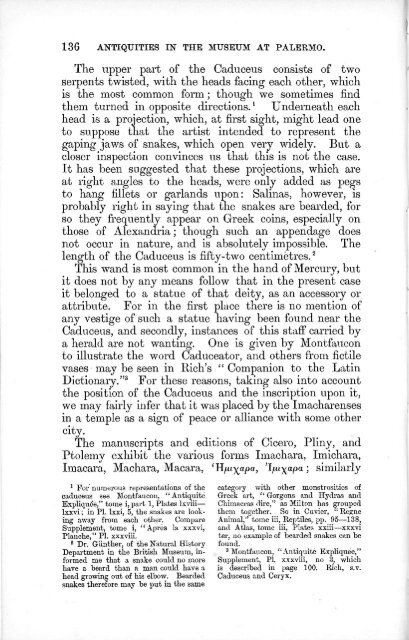Sicily presents to the ordinary tourist attractions which in number ...
Sicily presents to the ordinary tourist attractions which in number ...
Sicily presents to the ordinary tourist attractions which in number ...
You also want an ePaper? Increase the reach of your titles
YUMPU automatically turns print PDFs into web optimized ePapers that Google loves.
136 ANTIQUITIES IN THE MUSEUM AT PALERMO.<br />
The Tipper part of <strong>the</strong> Caduceus consists of two<br />
serpents twisted, with <strong>the</strong> heads fac<strong>in</strong>g each o<strong>the</strong>r, <strong>which</strong><br />
is <strong>the</strong> most common form; though we sometimes f<strong>in</strong>d<br />
<strong>the</strong>m turned <strong>in</strong> opposite directions. 1 Underneath each<br />
head is a projection, <strong>which</strong>, at first sight, might lead one<br />
<strong>to</strong> suppose that <strong>the</strong> artist <strong>in</strong>tended <strong>to</strong> represent <strong>the</strong><br />
gap<strong>in</strong>g jaws of snakes, <strong>which</strong> open very widely. But a<br />
closer <strong>in</strong>spection conv<strong>in</strong>ces us that this is not <strong>the</strong> case.<br />
It has been suggested that <strong>the</strong>se projections, <strong>which</strong> are<br />
at right angles <strong>to</strong> <strong>the</strong> heads, were only added as pegs<br />
<strong>to</strong> hang fillets or garlands upon: Sal<strong>in</strong>as, however, is<br />
probably right <strong>in</strong> say<strong>in</strong>g that <strong>the</strong> snakes are bearded, for<br />
so <strong>the</strong>y frequently appear on Greek co<strong>in</strong>s, especially on<br />
those of Alexandria; though such an appendage does<br />
not occur <strong>in</strong> nature, and is absolutely impossible. The<br />
length of <strong>the</strong> Caduceus is fifty-two centimetres. 2<br />
This wand is most common <strong>in</strong> <strong>the</strong> hand of Mercury, but<br />
it does not by any means follow that <strong>in</strong> <strong>the</strong> present case<br />
it belonged <strong>to</strong> a statue of that deity, as an accessory or<br />
attribute. For <strong>in</strong> <strong>the</strong> first place <strong>the</strong>re is no mention of<br />
any vestige of such a statue hav<strong>in</strong>g been found near <strong>the</strong><br />
Caduceus, and secondly, <strong>in</strong>stances of this staff carried by<br />
a herald are not want<strong>in</strong>g. One is given by Montfaucon<br />
<strong>to</strong> illustrate <strong>the</strong> word Caducea<strong>to</strong>r, and o<strong>the</strong>rs from fictile<br />
vases may be seen <strong>in</strong> Rich's " Companion <strong>to</strong> <strong>the</strong> Lat<strong>in</strong><br />
Dictionary." 3 For <strong>the</strong>se reasons, tak<strong>in</strong>g also <strong>in</strong><strong>to</strong> account<br />
<strong>the</strong> position of <strong>the</strong> Caduceus and <strong>the</strong> <strong>in</strong>scription upon it,<br />
we may fairly <strong>in</strong>fer that it was placed by <strong>the</strong> Imacharenses<br />
<strong>in</strong> a temple as a sign of peace or alliance with some o<strong>the</strong>r<br />
city.<br />
The manuscripts and editions of Cicero, Pl<strong>in</strong>y, and<br />
P<strong>to</strong>lemy exhibit <strong>the</strong> various forms Imachara, Imichara,<br />
Imacara, Machara, Macara, Ήμι-^αρα, Ίμιχαρα; similarly<br />
1 For' numerous representations of <strong>the</strong><br />
caduceus see Montfaucon, "Antiquite<br />
Expliqude," <strong>to</strong>me i, part 1, Plates lxviii—<br />
lxxvi; <strong>in</strong> PL lxxi, 5, <strong>the</strong> snakes are look<strong>in</strong>g<br />
away from each o<strong>the</strong>r. Compare<br />
Supplement, <strong>to</strong>me i, "Apres la xxxvi,<br />
Planche," PI. xxxviii.<br />
2 Dr. Gi<strong>in</strong><strong>the</strong>r, of <strong>the</strong> Natural His<strong>to</strong>ry<br />
Department <strong>in</strong> <strong>the</strong> British Museum, <strong>in</strong>formed<br />
me that a snake could no more<br />
have a beard than a man could have a<br />
head grow<strong>in</strong>g out of his elbow. Bearded<br />
snakes <strong>the</strong>refore may be put <strong>in</strong> <strong>the</strong> same<br />
category with o<strong>the</strong>r monstrosities of<br />
Greek art, " Gorgons and Hydras and<br />
Chimaeras dire," as Mil<strong>to</strong>n has grouped<br />
<strong>the</strong>m <strong>to</strong>ge<strong>the</strong>r. So <strong>in</strong> Cuvier, " Regne<br />
Animal," <strong>to</strong>me iii, Reptiles, pp. 95—138,<br />
and Atlas, <strong>to</strong>me iii, Plates xxiii—xxxvi<br />
ter, no example of bearded snakes can be<br />
found.<br />
3 Montfaucon, "Antiquite Expliquee,"<br />
Supplement, PI. xxxviii, no 3, <strong>which</strong><br />
is described <strong>in</strong> page 100. Rich, s.v.<br />
Caduceus and Ceryx.

















